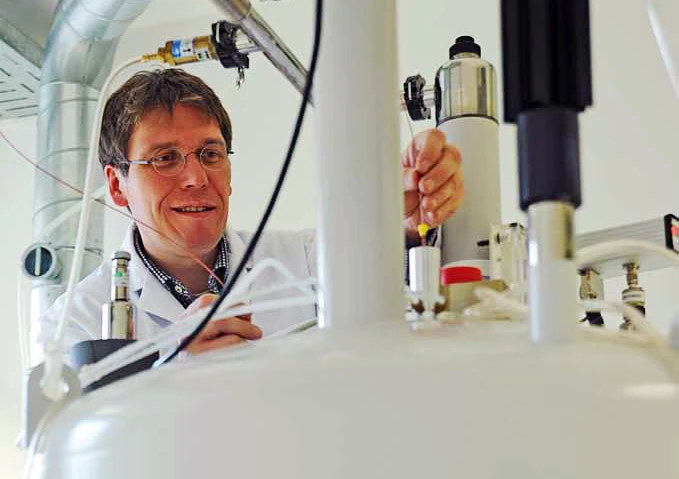In-line, on-line, at-line
Chemical Process Analysis at the BAM Federal Institute for Materials Research and Testing
Now and again, Michael Maiwald slips into his lab coat and lends a hand in the laboratory, for example, to use the Online Electron Spin Resonance Spectrometre. Its precision and ability to measure the concentration of substances in liquids in absolute terms, and without the use of reference samples, make it an especially valuable measurement device for the director of the department Chemical Process Analysis at the BAM Federal Institute for Materials Research and Testing can be used as a reference himself – for the development of measurement devices in process analysis.
Whether yeasts in biochemical reactors turn sugar into vaccines, or plastics are produced from various gases and liquids in the chemical industry – exact knowledge of the processes, or of the purity and composition of base, middling and end products play an increasingly important role. ”Faced with international competition, we have to see that we produce precisely in the quality required and with the highest possible efficiency,“ Maiwald points out. Even today, according to his cautious estimate, the process industry allows itself the luxury of up to 30 percent of waste.
Moreover, raw materials are becoming scarcer and more valuable. In order to be able to prevent production rejects at an early stage, the individual steps that make up processes will have to be monitored more closely. ”Basically, we already have the measurement technology for this,“ says Maiwald. Optical methods are particularly suitable because they are non-destructive and do not require sample preparation. With regard to compact lab facilities, these methods have to be made fit for the requirements of production. Preferably no one in a lab coat should have to be watching. Measurements, possible sample extraction, data evaluation – all this should run automatically. And the equipment has to be robust enough
to function under the harsh conditions of production, such as heat, pressure, and mechanical stress.
Processes in reactors require collecting data from different spatial zones. ”Furthermore, we need realtime results, meaning results that are not only measurement, but also decision data which can be fed back into task management,“ Maiwald emphasises. Accomplishing all of this is no easy task, especially for the chemical and pharmaceutical industries which often work with processes that have been tried and tested over many decades. Here, change occurs only very slowly. Maiwald and his process analytics group at BAM want to make a difference with regard to both technical aspects and the political level. They provide reference procedures and further develop, for example, the electron spin resonance spectrometer with its very high measurement precision for analysing gases. Together with users from the industry and device developers, the chemist is pushing for the drawing up at a roadmap which conceives process analytics as a central component of Industry 4.0. Here, the trend is towards interlinked manufacturing facilities and intelligent products that know their history, but also alternative ways to reach their target state. This also paves the way for individualised production of, for example, single patient medication. This makes it particularly important to ensure the quality control of the final products already during the production process.
by Uta Deffke for Adlershof Special
